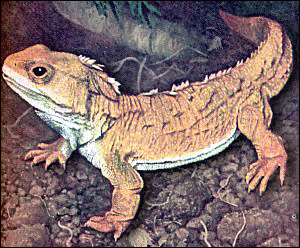 CLASSIFICATION
Kingdom: Animalia
Phylum: Chordata
Class: Reptilia
Order:
Sphenodontia ("wedge tooth")
Family: Sphenodontidae
Genus
species: Sphenodon punctatus
GENERAL
INFO
Tuataras may be olive, grey, or brickish red in
color. They range in adult length from about 40cm to 60cm.
It's not uncommon for an individual to live for over 100 years.
Prefered body tempature is about 60-70 degrees. They are also
ectothermic.

A male tuatara named Henry,
living at the Southland
Museum and Art Gallery, is still reproductively active at 111 years of
age.
SPECIAL FEATURES
Tuataras,
like msany other chordates, have a parietal eye on the top of their
head. The function of the is currently unknown; however it may help
regulate temperature or circadian rhythms, because it is part of the
epithalamus, which controls those processes.
HABITAT
The
geographic range that the tuatara lives in is a difficult niche to live in
for any species, particularly a reptile. The two recognized species of
tuatara are found on approximately 30 small, relatively inaccesible
islands off the coast of New Zealand. The island is cliff-bound, and
exposed to strong winds.Cold and damp, with temperatures ranging from 45
to 80, with humidity level of about 80%.
DIET
A
tuatara's diet includes arthopods, earthworms, snails, bird eggs, small
birds, frogs, lizards, and a type of native cricket-like insect the size
of a mouse called a weta. Small tuataras are also sometimes
cannibalized. Tuataras eat less frequently than other reptiles due
to its slow metabolism.
REPRODUCTION
It
takes about 10 to 20 years for a Tuatara to reach sexual maturity. The
female, on average, lays between 5 - 18 eggs only once every 4 years, the
longest reproduction cycle of any reptile. Incubation takes about 12 to 15
months with the develpotment of the embryo stopping during the winter
months. At 22° C, 80% of tuatara incubated would hatch into males,
at 20° C, 80% were likely to be females, and at 18° C, all the tuatara
hatched were females.
BODY SYSTEMS
The tuatara spine is made up of hour-glass shapped amphicoelous
vertabrae, concave both before and behind. This condition is is
usually found in fish and some amphibians, but is unique to the
Tuartara. Together with turtles, the tuatara has the most primitive
hearing organs among the amniotes. There is no eardrum and no
earhole.
HUMAN
IMPACT
Tuatara were pushed off of mainland New
Zealand, like many other endangered species, they could not breed fast
enough to keep up from the death rate caused by predators and
people. That's why they are only found on offshore islands and
mainland sanctuaries.
WEBLINKS
http://www.kcc.org.nz/tuatara
SOURCES
http://mantisshrimp.wordpress.com/2009/03/15/tuatara-most-primitive-reptile/
http://www.kcc.org.nz/tuatara
http://animaldiversity.ummz.umich.edu/site/accounts/information/Sphenodon_punctatus.html
http://en.wikipedia.org/wiki/Tuatara
http://www.qis.net/~captain/custom/bkground.jpg
| 
